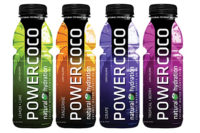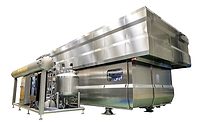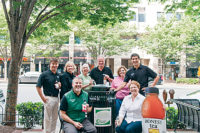Organic
Opportunities
By ELIZABETH FUHRMAN
Organic beverage sales are booming. But why, and
who are these consumers?
No longer considered
specialty products, organic foods and beverages are earning mainstream
popularity as more consumers are finding their way to organic products. For
the 52 weeks ending March 19, 2005, organic beverage sales reached more
than $1.1 billion, which was up 14.1 percent from the same period a year
ago, according to San Fransisco-based SPINS’ SPINSscan
Conventional and Natural Channels.
Organic dairy beverages are leading the organic
beverage category with $263.6 million in sales. Along with organic
non-dairy beverage sales at $213.7 million, organic teas at $131.8 million,
organic shelf stable juices and functional drinks at $102 million and
organic refrigerated juices and functional beverages at $66.3 million, the
top five organic beverages make up about 70 percent of the total category.
| Top Five Organic Beverage Categories | |
| Category | Sales (in millions) |
| Milk, Half & Half, Cream | $263.6 |
| Non-Dairy Beverages | $213.7 |
| Teas | $131.8 |
| Shelf-Stable Juices & Functional Drinks | $102.0 |
| Refrigerated Juices & Functional Drinks | $66.3 |
| Source: SPINSscan Conventional and Natural Channels for the 52 weeks ending March 19, 2005 in conventional food, drug and mass and natural supermarkets. | |
According to the Natural Marketing Institute (NMI) in
Harleysville, Pa., total organic food and beverage sales in the United
States reached $10.9 billion in 2004. While overall organic food and
beverage sales have doubled during the past five years, year-to-year growth
rates have been receding from 23 percent in 2000 to a more modest 18
percent in 2004. This could indicate a slowing of sales growth to a more
sustainable rate, but could also be a sign that the number of organic
consumers must be increased to sustain industry growth, according to
NMI’s Organic Consumer Trends Report 2005. Assuming that sales
continue growing at slower annual rates, by
2007 organic food and beverage sales are
projected to reach $15.4 billion, the report says.
Ten years ago, the large majority of organic food and
beverage sales were found in natural food channels. As recently as 2000, 60
percent of organic sales were in the natural channels such as Whole Foods
Market, Wild Oats and Trader Joe’s, while 30 percent came from
grocery. However, in 2004 the gap between natural and mainstream channels
narrowed to 46 percent in natural channels vs. 44 percent in mainstream
grocery.
An increase in overall food and beverage sales in mass
merchandise outlets also resulted in increased organic sales. In 2004,
organic sales in grocery plus mass channels surpassed 50 percent of total
industry sales for the first time. NMI expects these trends to continue
with organic sales in grocery stores anticipated to surpass organic sales
in the natural channel this year and with mass merchandisers’ share
approaching 10 percent of the total organic sales by 2007.
“There are now more organic products available
than ever before, and they are available in more venues than before so more
shoppers have the chance to see the product, try the product and hopefully continue to use the product and find products
that meet their tastes,” says Holly Givens, communications director
for the Organic Trade Association in Greenfield, Mass. “There really
is now an organic product out there for every taste, and beverage is
included in that.”
With regard to consumers’ need to use organic
beverages, the category compared to packaged food and produce, showed the
least necessity (27 percent vs. 35 percent and 44 percent, respectively) in
NMI’s Organic Consumer Trends Report 2005. Twelve percent of
consumers currently are using organic beverages, with another 15 percent of
the population indicating a desire, but not currently using them.
Making sense of organic
The term organic relates to the way ingredients are
grown and processed. Little scientific evidence exists to prove that
organic foods or beverages are healthier than non-organic. However,
consumers have embraced organic as being synonymous with health. More than
half of devoted organic consumers first tried organic beverages for their
overall health, reports NMI.
“As shoppers learn more about their health and
are concerned about living healthfully, they also see organic as fitting in
well with that,” Givens says. “So even news about the food
pyramid generally raises people’s awareness a little bit, gets them
thinking and sometimes translates into interests in organic.”
Another third of regular organic users feel organic
beverages are better for their families. Taste, nutrition content,
preventing health issues, environmental concerns and safety then follow as
reasons consumers start using organic beverages.
It’s true that official standards have been in
place since 2002 and organic beverages continue to generate more consumer
dollars, but being organic isn’t so simple. In order to sell products
labeled as USDA Organic by the U.S. Department of Agriculture,
manufacturers must adhere to a strict set of regulations. Organic
processors must be certified by an agency that has been accredited by the
USDA, which fully inspects farm and factory to make sure all the rules
necessary to meet USDA Organic standards are followed. Companies that
handle or process organic products must be certified as well. The name and
address of the government-approved certifier also must appear on all
packaged products that use organic ingredients.
But what does it really mean?
Organic food is grown without relying on synthetic
chemical pesticides. Organic farmers are required by the National Organic
Standards to minimize soil erosion, implement crop rotations and prevent
contamination of crops, soil or water by plant and animal nutrients,
pathogenic organisms, heavy metals or residues of prohibited substances.
Organic farming also conserves natural resources by recycling natural
materials and encourages an abundance of species living in balanced
ecosystems.
La Farge, Wis.-based Organic Valley Family of Farms
began in 1988 with just seven farmers and has grown into America’s
largest independent cooperative of organic farms and one of the largest
organic brands on the market. Organic Valley announced its best-ever year
in 2004 with $208 million in sales, increasing 33 percent over its $156
million in 2003. It grew to a total of 689 organic farmers in 20 states.
Organic Valley expects to continue this course of growth in 2005 with
projected sales of $259 million.
New to the company’s beverage lineup, Organic
Valley released Soy in Original, Vanilla and Chocolate varieties. The
half-gallon cartons are vitamin A-, B2-, B12- and D2-fortified and have no
beany aftertaste or chalkiness.
Offering a complete line of organic milk and juice
products, Longmont, Colo.-based Horizon Organic, a division of Dallas-based
Dean Foods Co., owns and operates an organic farm in Idaho and dairy farm
in Maryland. This year, the Cornucopia Institute, an advocacy group
for small family farms, filed a complaint with the USDA about three major
dairies, including Horizon Organic, alleging that these operations
don’t comply with organic rules that require cows to feed on pasture
grass. Instead, the complaints say, farms confine cows to feedlots and feed
them organic grain, a less expensive method of production. The USDA has
started an investigation into the complaints.
| Reasons devoted organic users choose organic beverages | |
| Overall health | 55% |
| Better for me/family | 32% |
| Taste | 29% |
| Nutrition content | 25% |
| Prevent health issues | 22% |
| Environmental concerns | 20% |
| Safety | 14% |
| Source: The Organic Consumer Trends Report 2005, The Natural Marketing Institute, Harleysville, Pa. | |
Horizon Organic, the largest U.S. organic dairy
marketer, says it strongly believes in the importance of organic
agriculture, not only to provide the best-tasting, highest-quality dairy
and juice products, but also to encourage a safe future for the planet. One
of its top priorities, the company says, is the humane treatment of
animals. Cows that supply Horizon Organic with milk are not treated with
antibiotics or growth hormones, and are fed only 100 percent certified
organic cottonseed, hay and grain. The cows also have access to clean
water, fresh air, pasture and exercise. Horizon Organic also purchases
about two-thirds of its organic milk from family and independent
certified-organic dairy farmers across the country. Through the
company’s feed and milk supply purchases, it says it supports more
than 200,000 acres of organic farmland.
To keep the organic message alive, Horizon Organic
launched a national education initiative dubbed the “Year of Organic
Good Beginnings.” The campaign aims to promote “the positive
role that organic food plays in the overall health and well-being of
consumers.” The program includes a grant to a nonprofit group –
the National Healthy Mothers, Healthy Babies Coalition – to develop
and distribute a brochure on organic foods and nutrition. In a
back-to-school campaign this fall, the company will focus on promoting
organic foods in children’s lunch boxes.
Regarding lunch boxes, Horizon Organic launched a line
of kid-friendly smoothies in 2004, made with organic nonfat yogurt and
fruit juices. The beverages are available in four flavors –
Wild Berry Blast, Strawberry Banana Splash and Tropical Fruit Punch –
and deliver calcium and 100 percent of the recommended daily intake of
vitamin C per serving. The company also released Horizon Organic Single
Serve Aseptic Juice in multipacks of eight 6.75-ounce boxes. The
shelf-stable Apple, Grape and Fruit Punch flavors contain 100 percent juice
and contain 100 percent of the recommended daily intake of vitamin C.
Crossovers
The billion-dollar organic beverage market has proved
difficult for some major players to ignore. Starting in August, Ocean Spray
in Lakeville-Middleboro, Mass., will begin distributing Ocean Spray Organic
100 Percent Juice Blends. Available in Cranberry Blend, Cranberry Blueberry and Cranberry Raspberry,
the products are certified USDA Organic
and are packaged in 32-ounce glass bottles for $3.99.
“Our short-term plan is to get into natural food
channels like Whole Foods and Wild Oats, and then depending on our crop
supply as well as our ability to support, we’re going to expand
regionally into some groceries,” says Jared Konstanty, director of
marketing, domestic beverages, for Ocean Spray. “At the moment, the
company is accessing the marketplace where the highest development is for
the organic section and where we thought would be the most opportunity for
us.”
Ocean Spray is an agricultural cooperative owned by
more than 650 cranberry growers as well as more than 100 Florida grapefruit
growers. Ocean Spray has been a best-selling brand in the canned and
bottled juice category since 1981 and posted fiscal gross sales of roughly
$1.4 billion in 2004.
“We believe our brand name in the organic world
will definitely be an advantage, primarily due to the fact that we have a
long association with farming, obviously with the harvesting of fruit, but
also just our trusted brand name and our strong tie to high-quality
products and cranberry expertise above all else,” Konstanty says.
Ocean Spray feels the organic launch will attract new
consumers for two reasons. “No. 1, it’s a really different
benefit that consumers are looking for that in our current line we
don’t deliver,” Konstanty explains. “Consumers take those
benefits very seriously and they behave very rigidly within that
world.”
No. 2, the line is
distributed in a different section of the grocery store and different
channels that Ocean Spray traditionally
hasn’t gotten into. “An $18
billion organic and natural food segment has emerged that we don’t
participate in,” Konstanty says.
Jones Soda Co., Seattle, entered the organic food
trade this year, too. In April, Jones Soda released a new line of organic
teas called Jones Organics. The six tea flavors – Strawberry White
Tea, Cherry White Tea, Berry Green Tea, Mandarin Green Tea, Tropical Red
Tea and Peach Red Tea – will all be featured in 12-ounce glass
bottles.
“Organics is a nice segue into offering products
that are more healthy and natural,” says Mike Spear, brand manager
for Jones Organics.
Bethesda, Md.-based Honest Tea Inc. already has
established itself as a leader in the ready-to- drink organic tea category
with 40 percent of the market share in dollar sales for the year ending
March 19, 2005, according to SPINSscan Natural, which tracks sales in
natural supermarkets. But Honest Tea isn’t planning on stopping at
success only in natural channels. Honest Tea’s Heavenly Green Tea has
been a strong crossover product – an organic product that commands
attention in all channels – says Seth Goldman, president and
“TeaEO” of Honest Tea.
“We have seen this item gain approval everywhere
from 7-Eleven to vending machines,” he says. “In
fact, a [Washington] D.C.-based vending machine company just ordered five
vending fronts with a big picture of a bottle of Heavenly Honey Green on
the front. This to me is a great illustration of how organics are moving
beyond the usual natural foods channels.”
Unlike organic beverages of the past, Heavenly Honey
Green also delivers a mainstream taste and packaging with the health
benefits of green tea. “It is packaged with a visually compelling
label and bottle that makes it competitive with any bottled green tea on
the market,” Goldman says.
Organic beers
Although not in the top five leading organic beverages
yet, organic beers are proving to be another way for the organic and craft
brewer’s categories to grow. Wolaver’s Organic Ales, a division
of Otter Creek Brewing in Middlebury, Vt., offers five styles of ales
– India Pale Ale, Pale Ale, Brown Ale, Oatmeal Stout and Wit Bier
– distributed in 22 states, primarily in the East Coast, West Coast
and Mid-Atlantic.
With the more than 200 million barrels of beer
consumed in America per year, only 30,000 barrels are organic, estimates
Morgan Wolaver, president of Otter Creek Brewing/Wolaver’s Organic
Ales. As the largest producer of domestic organic beer, Wolaver’s
Organic Ales will sell about 8,000 barrels of organic beer in 2005, which
represents at least 50 percent of the domestic organic market, he says.
“Certainly when you look at the number of
organic breweries out there, there are not that many of us,” Wolaver
says. “We’re so small now. Craft-brewed beers are only 4
percent of the total beer consumption and then if you look at organic beers
we’re just a fraction. I think there soon will be more styles than
what’s available now.”
While domestic organic beers still are the primary
products in the U.S. market, a significant number of imported organic beers
began entering the domestic market in 2004. “Organic beers have taken
on a much bigger awareness in Europe than they have in America,”
Wolaver says.
If many consumers turn to organic beverages because
organic products are perceived healthier, why then would an organic user be
attracted to beer when it’s not typically considered a health drink?
“Organics is really a bigger issue than thinking
of our health,” Wolaver says. “It’s also the health of
our environment. It’s really part of the sustainability of our planet
as well. Our core consumers certainly look at it in that respect to see if
we are good stewards of our environment … They know with their buying
power they can make a difference in the environment.”
Organic beer consumers are label readers as well.
Alcohol beverages and even craft brewers aren’t required to list
ingredients, but Wolaver’s Organic Ales lists everything that goes
into the products. The other feature organic beer consumers are interested
in is brand relevance.
“They want to take a step further and look at us
as a company to see what we’re doing, whether it’s being a
sustainable company, whether it’s energy efficiencies or whether
we’re environmentally conscious,” Wolaver says. BI
Organic, biodynamic and beyond
The USDA Organic label can
be confusing enough to some consumers, but some producers think the
designation isn’t enough. The commercialization of organics has
started a backlash from activists who are trying
to popularize other terms, such as “Biodynamic” “Food Alliance Certified,” “local”
and even “beyond organic.” Below is a brief breakdown of what
these labels represent:
Food Alliance Certified – indicates that the
food was grown on a farm that met specific standards for the treatment of
farm workers, wild life habitat and pesticide use. The Food Alliance,
Portland, Ore., certifies both producers and processors.
Biodynamic – depicts farms that are almost
complete ecosystems. Demeter Inc., Junction City, Ore., oversees the term
and certifies producers, processors and handlers.
LIVE – stands for Low Input Viticulture and
Enology Inc., Veneta, Ore., and represents soil management, biodiversity,
conservation and watershed protection for wineries and vineyards.
Certified Naturally Grown – represents a
producer who is held to the same standards as the USDA National Organic
Program materials list as well as residue testing, soil management and
biodiversity regulations by New Paltz, N.Y.-based Certified Naturally
Grown.
Local, Sustainable and Beyond Organic – are
terms not overseen by special agencies, but are used by various food
producers to indicate alternative practices.


